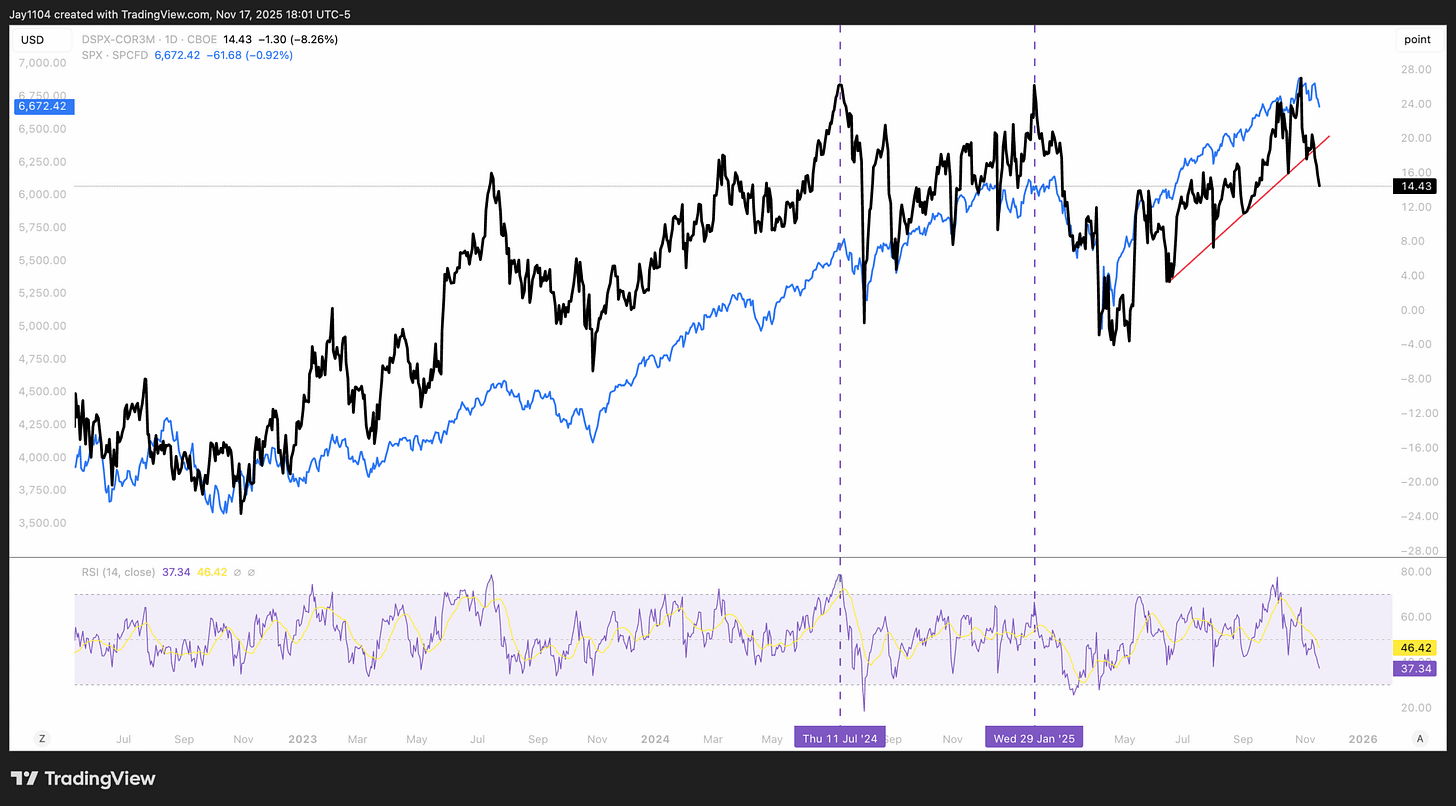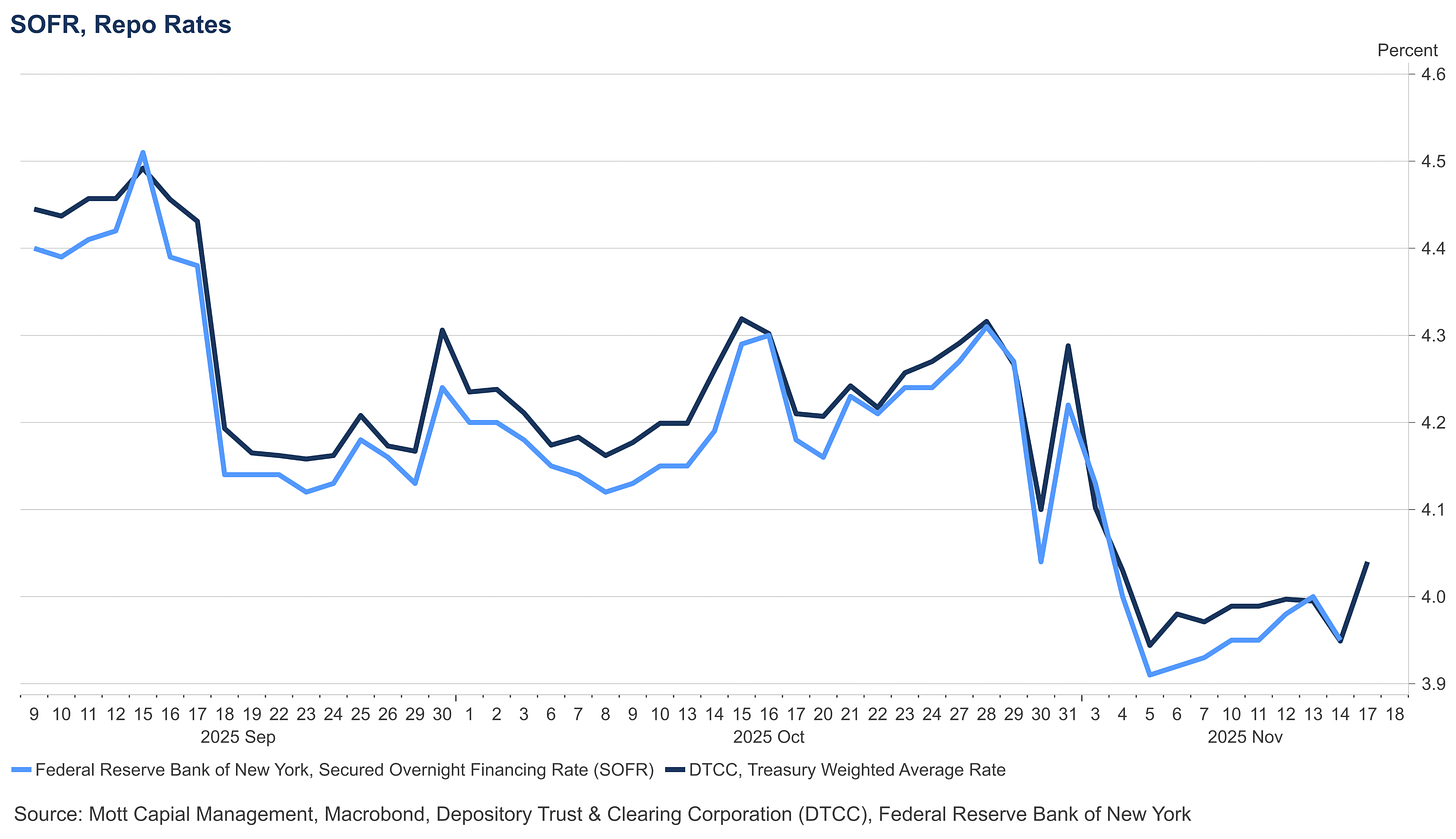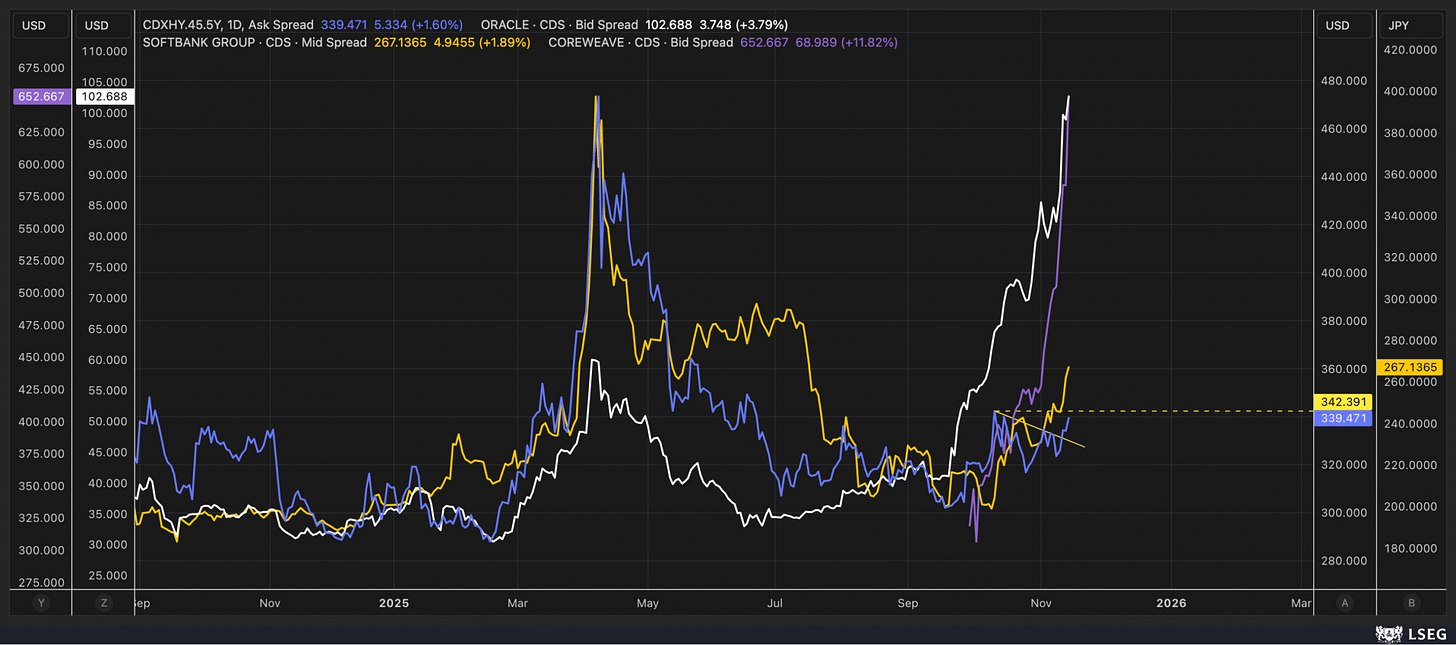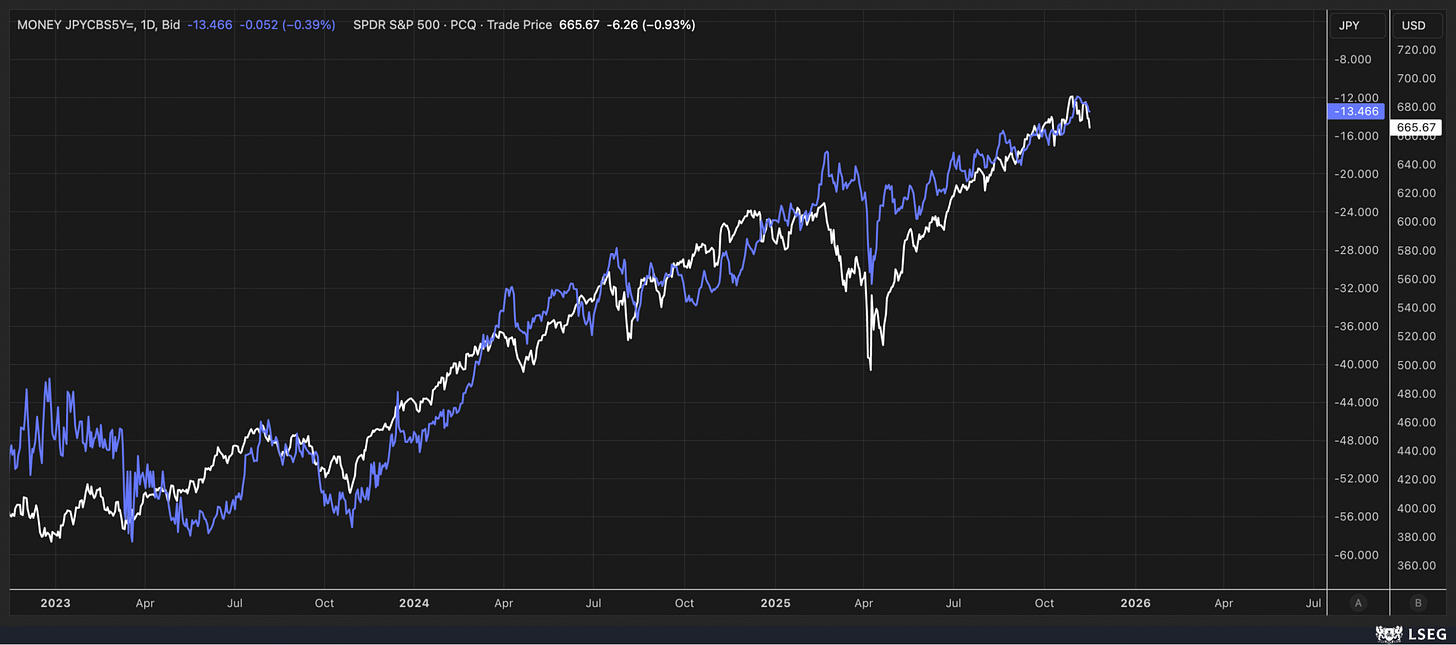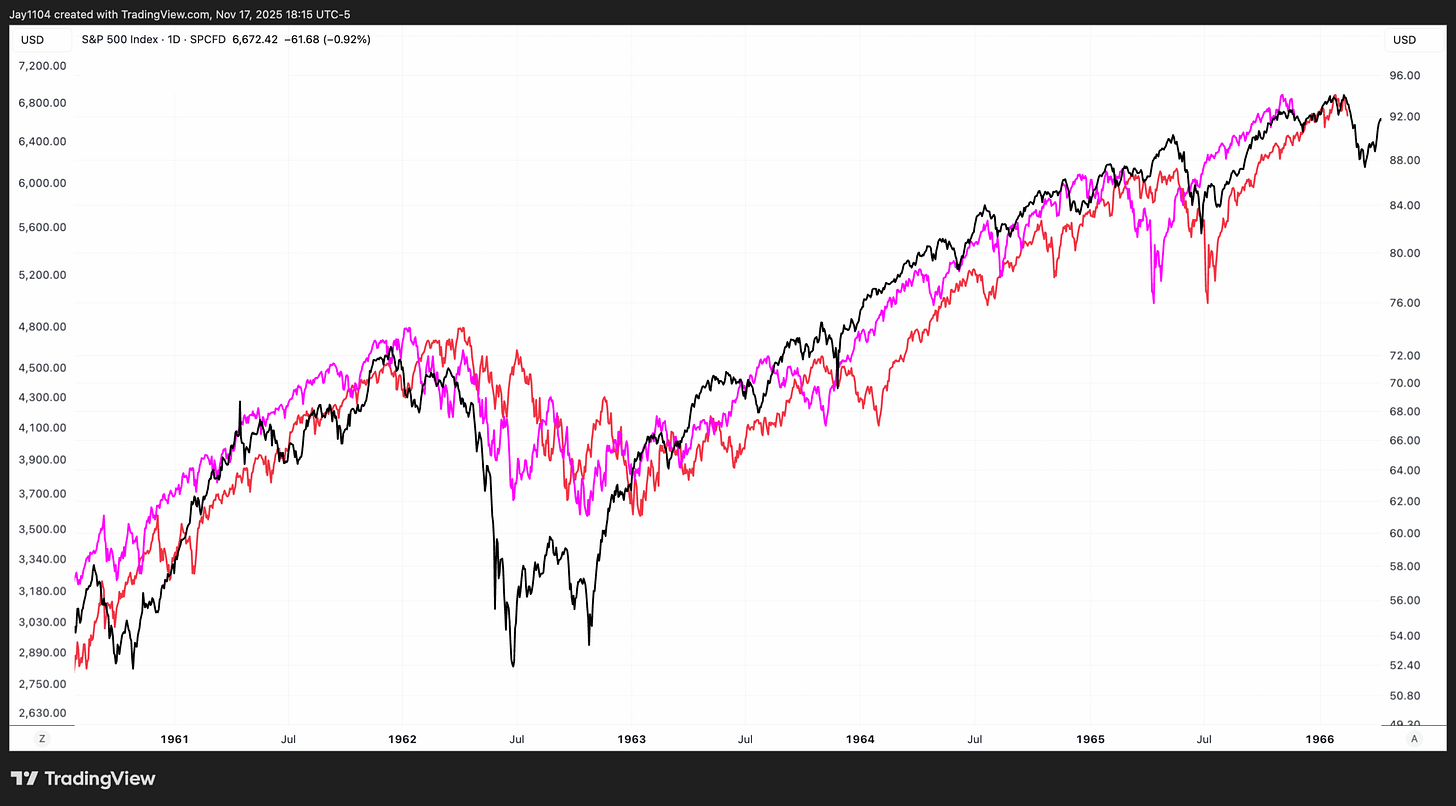The Bear Emerges as Funding Stress and Credit Risks Deepen
Now through December 3rd, enjoy 20% OFF Navigating The Market
I will be presenting at the MoneyShow virtual expo on November 12; you can watch me here, for FREE
The S&P 500 fell by about 1% on the day, reversing the recent string of Monday rallies. Not surprisingly, the index attempted to rally in the mid-morning as volatility declined. However, the market had already opened lower, and while we saw a brief rebound around 10 a.m., those gains faded quickly, as today was a Treasury settlement date.
Tomorrow is also a Treasury settlement date, and we’re already seeing repo rates move back above 4% for today. For now, the S&P 500 continues to hold around 6,750, which remains the key sticking point. Every time the index gets there, it bounces off that level or near it, but at some point, that region is likely to break.
Given the small end-of-day surge, it wouldn’t be surprising if we gap lower tomorrow, undercut the 6,640 low, and continue to see pressure throughout the day—potentially even testing 6,600 or moving below it.
Also, we’ve seen the dispersion trade continue to unwind, with three-month implied correlations rising faster than the dispersion index today, further narrowing that spread. This unwind should only grow strong after Nvidia reports.
The average repo rate at DTC today was around 4.04%, suggesting we’ll see SOFR push above 4% tomorrow as well. With another settlement date tomorrow, there’s a chance funding conditions will tighten further and those rates move even higher.
Wednesday should bring some relief since there are no settlements, and midweek typically sees a bit of easing. But by Thursday, I would expect rates to tighten again, with repo potentially pushing back toward that 4% corridor. That would also put upward pressure on usage of the Standing Repo Facility.
The CDX High Yield credit spread index also moved higher today and appears to have broken a downtrend. It’s now approaching a resistance level around 342, which was last seen in mid-October. A breakout above 342 would likely signal even wider spreads ahead, and that wouldn’t be surprising given the rise we’re already seeing in CDS spreads for companies like Oracle, Meta, and CrowdStrike. We’re even seeing similar moves in names like SoftBank in Japan.
So it wouldn’t be surprising at all to see credit spreads widen more broadly across the market—and that would clearly be negative for equities overall.
The final piece of the puzzle may actually be coming from Japan, where rates are rising rapidly amid concerns over new stimulus proposals, making markets increasingly nervous. This has pushed yields sharply higher across the curve, with the 10-year rising to 1.73%—the highest level since 2008. More importantly, there appears to be room for yields to move even higher in the near term, with the next potential resistance level likely somewhere around 1.90%.
If concerns over the government’s spending plan persist and Japanese rates continue to rise while the yen weakens, it could trigger a flight to safety into the dollar. That would likely lead to a materially stronger dollar against the yen and to higher dollar funding costs. In that scenario, the Japanese yen five-year cross-currency basis swap would move lower—becoming more negative—widening the spread and making it more costly for Japanese investors to fund U.S. dollar trades.
This would obviously suck even more liquidity out of the market.
Finally, the 1966 analogue continues to track the S&P 500’s present moves. For whatever it is worth.
Mike
Glossary by ChatGPT
CDS (Credit Default Swap): A contract that provides protection against the default of a borrower by transferring credit risk between parties.
CDX High Yield Index: A benchmark index tracking credit default swaps on high-yield corporate debt.
Cross-Currency Basis Swap: A swap allowing two parties to exchange interest payments and principal in different currencies, reflecting funding costs between them.
Dispersion Trade: A strategy involving long or short volatility positions on an index versus its individual components.
Implied Correlation: A measure derived from option pricing that reflects expected co-movement among assets.
Repo Rate: The interest rate charged in repurchase agreements, where securities are used as collateral for short-term borrowing.
SOFR (Secured Overnight Financing Rate): A benchmark rate measuring the cost of overnight borrowing collateralized by U.S. Treasury securities.
Standing Repo Facility: A Federal Reserve tool providing overnight loans against Treasury collateral to manage short-term interest rates.
Treasury Settlement Date: The date when cash and securities are exchanged to finalize a Treasury transaction.
Disclosure
This report contains independent commentary to be used for informational and educational purposes only. Michael Kramer is a member and investment adviser representative with Mott Capital Management. Mr. Kramer is not affiliated with this company and does not serve on the board of any related company that issued this stock. All opinions and analyses presented by Michael Kramer in this analysis or market report are solely Michael Kramer’s views. Readers should not treat any opinion, viewpoint, or prediction expressed by Michael Kramer as a specific solicitation or recommendation to buy or sell a particular security or follow a particular strategy. Michael Kramer’s analyses are based upon information and independent research that he considers reliable, but neither Michael Kramer nor Mott Capital Management guarantees its completeness or accuracy, and it should not be relied upon as such. Michael Kramer is not under any obligation to update or correct any information presented in his analyses. Mr. Kramer’s statements, guidance, and opinions are subject to change without notice. Past performance is not indicative of future results. Neither Michael Kramer nor Mott Capital Management guarantees any specific outcome or profit. You should be aware of the real risk of loss in following any strategy or investment commentary presented in this analysis. Strategies or investments discussed may fluctuate in price or value. Investments or strategies mentioned in this analysis may not be suitable for you. This material does not consider your particular investment objectives, financial situation, or needs and is not intended as a recommendation appropriate for you. You must make an independent decision regarding investments or strategies in this analysis. Upon request, the advisor will provide a list of all recommendations made during the past twelve months. Before acting on information in this analysis, you should consider whether it is suitable for your circumstances and strongly consider seeking advice from your own financial or investment adviser to determine the suitability of any investment.




